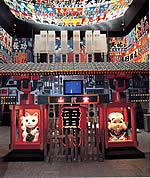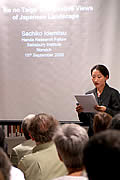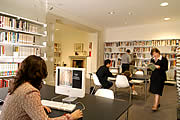 In November 2005, The Order of the Rising Sun, Gold Rays with Neck Ribbon was bestowed upon Dame Elizabeth Esteve-Coll DBE in recognition of her outstanding contribution to the promotion of Japanese culture and studies to British people. In November 2005, The Order of the Rising Sun, Gold Rays with Neck Ribbon was bestowed upon Dame Elizabeth Esteve-Coll DBE in recognition of her outstanding contribution to the promotion of Japanese culture and studies to British people. |
Q1. How did you feel when you heard that a Japanese honour had been bestowed upon you?
I was completely amazed by the news and immediately felt humble and quite undeserving and then of course, hugely proud and honoured to have been selected for such a prestigious recognition of my small contribution to a better understanding of Japanese life and culture in Britain.
Q2. Please describe how your fascination with Japanese art and culture began and how it has developed over the years.
Whilst a student at Trinity College, Dublin, I visited the Chester Beatty Library and was intrigued by the hand scrolls. In 1963 I made my first visit to Tokyo and went to a traditional theatre performance. The complexity and subtlety revealed by the layers of meaning intrinsic in this art form made a very powerful impression on me. My visit in 1988 as Director of the Victoria and Albert Museum renewed and deepened my interest in Japanese art forms.
Q3. Which aspects of Japanese art and culture are you personally most interested in and why?
The V&A has a very fine collection of Japanese ceramics and textiles. I was privileged to learn about these from Dr Rupert Faulkner, a senior curator in the Japanese Department.
Visiting the Mingeikan Museum with Dr Yanagi Sori in 1988 was another milestone in learning about the relationship of Japanese and English ceramicists in the late nineteenth and early twentieth centuries.
| The flagship Visions of Japan exhibition hosted by the V&A during the Japan Festival 1991 was most memorable. Its revolutionary and unique style attracted an unprecedented number of visitors. This highly inventive, powerful and entertaining exhibition produced by the famous Japanese architect Arata Isozaki was a milestone in the history of Japan-UK cultural relations ? it opened up people's minds to Japan, past, present and future. It had a timeless quality - even if were put on today or in the future, it would still appear fresh and innovative. |
 |
| Visions of Japan exhibition at the V&A in 1991 |
Q4. What do you think makes Japanese art so special?
The unique interplay of discipline, technical mastery and spirituality, which informs Japanese art and culture on so many levels. An example which intrigues the British public is of course the tea ceremony - both a complex ritual and a profound meditation.
Q5. What was the motivation behind the establishment of SISJAC?
Sir Robert and Lady Sainsbury wished to create a major centre in the UK which would nurture research and scholarship between British and Japanese scholars. I was privileged to be included in the early discussions and wished to lend my enthusiasm and energy to this visionary project. Sir Robert asked me to become a Trustee of the new Institute and help to guide it. The Sainsburys were keen to foster greater awareness of Japanese art in the wider public and so SISJAC has always tried to be a focus for research and dissemination of information to the general public.
Q6. What are the basic principles and the main purpose of SISJAC's activities?

Third Thursday Lecture Series, Norwich
|
SISJAC was founded to promote the study of the material and visual cultures of the Japanese archipelago and to be a catalyst for international scholars, postgraduate students and staff in collaborative and active research networks. Through seminars, symposia and publications, SISJAC facilitates and disseminates research on Japanese arts and culture to the widest international scholarly community.
Its recent activities include: the Toshiba Lectures in Japanese Art, this year by Dr Louise Cort from the Smithsonian Institution on the subject of 'Towards a better tea bowl: art, industry and ambition in 17th century Japan'; the publication of Hokusai and His Age: Ukiyo-e Painting, printmaking and Book Illustration in Late Edo Japan ; a Visiting Fellows programme; and monthly lectures for a general audience on the art and culture of Japan.
|
| |
SISJAC is an independent charity and is affiliated with the University of East Anglia (UEA) in association with the School of Oriental and African Studies, University of London (SOAS) and The British Museum.
Q7. What do you envisage for the future of SISJAC?
The future of SISJAC looks very bright. It has already established itself as a major player in international scholarship. Through its website it will broaden and deepen the shared expertise of contributing researchers. At its core is the Lady Lisa Sainsbury Library, currently the leading library in Europe for the study of Japanese arts and archaeology.
The Library began with a collection of 15,000 books generously donated by a Japanese scholar and has expanded to a current total of around 25,000. This number is set to increase as the Library expands its already strong collection on Japanese art and culture. |

Lisa Sainsbury Library, Norwich
|
We are trying to look at Japan from its roots and in all its manifestations. Japan is a multi-faceted country with great diversity. By understanding the dynamism of Japanese cultural history we can better comprehend the aesthetics of contemporary Japanese art and perhaps foresee what lies in store in the future.
|


